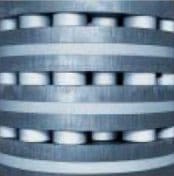 |
| Differences between Shunt Reactor and Power Transformer |
Main Differences
Shunt Reactor and Transformer both appear similar in construction. Reactors are also often equipped with Fans for cooling similar to Power Transformers.
However, there are major differences between the two. While a Power Transformer is designed for efficient power transfer from one voltage system to another, a shunt reactor is intended only to consume reactive VArs (or in other words it can be stated as to produce lagging VArs).
Thus, there are more than one winding on a Power Transformer with magnetic core which carry the mutual flux between the two. In reactor there is just one winding. The core is not therefore meant only to provide a low reluctance path for flux of that winding to increase the Inductance.
In case of a Power Transformer, primary Ampere-Turns (AT) is sum of exciting AT and secondary AT. AT loss (in winding resistance, eddy loss and hysteric loss) is kept to as minimum as possible. Exciting AT is small compared with the secondary AT. Rated current is based on the load transfer requirement.

Detailed view of an iron core divided by air gaps
Magnetizing current is small and is negligible value when compared with the secondary rated current. Further, since mutual flux is main flux which results in transformation, leakage flux is kept small and will be based on fault current limitation.
In case of a Shunt Reactor due to absence of other windings, all primary AT is equal to the exciting AT. Similar to a Power Transformer, loss in AT (in winding resistance, eddy current and hysteresis) are also kept to minimum by design. Magnetizing ATis major component of a Shunt Reactor. Reactor magnetizing current is its rated current.
Since a Shunt Reactor magnetizing current is large, if it is designed with Iron alone as a Power Transformer, there will be large hysteresis loss. Air gaps in Iron core are provided in a Shunt Reactor to reduce this loss and to minimize the remanent flux in the core.
Thus a Shunt Reactor may also be constructed without iron (air-core).
By construction, a Shunt Reactor can be oil immersed or dry type for both with and without iron core.
Dry type Reactors are constructed as single phase units and are thus arranged in a fashion to minimize stray magnetic field on surrounding (in the absence of metallic shielding). When such an arrangement is difficult, some form of magnetic shielding is required and designed with care to minimize eddy current loss and arcing at any joints within the metallic loops. One of the advantages of dry type reactor is absence of inrush current.
Oil immersed reactors can be core-less or with gapped iron core. These are either single phase or three phase design with or without fan cooling. These are installed within tanks which hold oil & act as metallic magnetic shields.
In some cases, a Shunt Reactor may have additional small capacity winding which can provide power for small station power loads. Since Shunt Reactor rating is normally based on MVAr rating, this added station load VA shall be accounted for in designing the Reactor for such applications.
 |
| Types of shunt reactors |
Shunt reactors are used in high voltage systems to compensate for the capacitive generation of long overhead lines or extended cable networks.
The reasons for using shunt reactors are mainly two
The first reason is to limit the overvoltages and the second reason is to limit the transfer of reactive power in the network. If the reactive power transfer is minimized i. e. the reactive power is balanced in the different part of the networks, a higher level of active power can be transferred in the network.
Reactors to limit overvoltages are most needed in weak power systems, i.e. when network short-circuit power is relatively low.
Voltage increase in a system due to the capacitive generation is:
ΔU(%) = QC x 100 / Ssh.c
where:
Qc is the capacitive input of reactive power to the network
Ssh.c is the short circuit power of the network
Ssh.c is the short circuit power of the network
With increasing short circuit power of the network the voltage increase will be lower and the need of compensation to limit over-voltages will be less accentuated.
Reactors to achieve reactive power balance in the different part of the network are most needed in heavy loaded networks where new lines cannot be built because of environmental reasons. Reactors for this purpose mostly are thyristor controlled in order to adapt fast to the reactive power required.
Especially in industrial areas with arc furnaces the reactive power demand is fluctuating between each half cycle.
In such applications there are usually combinations of:
- Thyristor controlled reactors (TCR) and
- Thyristor switched capacitor banks (TSC).
These together makes it possible to both absorb, and generate reactive power according to the momentary demand.
Four leg reactors also can be used for extinction of the secondary are at single-phase reclosing in long transmission lines. Since there always is a capacitive coupling between phases, this capacitance will give a current keeping the are burning, a secondary arc.
By adding one single-phase reactor in the neutral the secondary arc can be extinguished and the single-phase auto-reclosing successful.
Resource: Shunt Reactors and Shunt Reactor Protection - S.R. Javed Ahmed
No comments:
Post a Comment